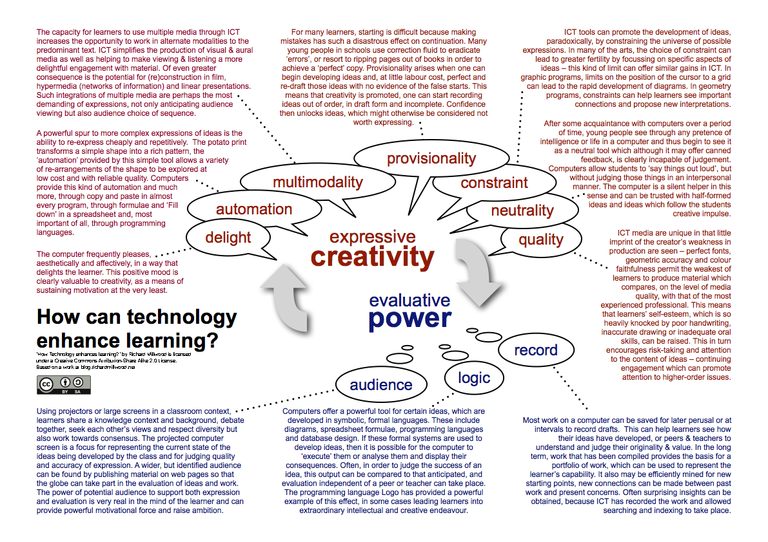[A2] How Can Technology Enhance Learning?
The expressive constructivism model of learning directs my attention towards the learner as an active, creative individual who is best served by tools for expression on the one hand and by tools for evaluation on the other.
This notion forms the basis of the following analysis in Figure 10 of key features of technology (the terms in the speech bubbles) that might enhance expression and evaluation.The text connected by dots to each bubble serves to explain the feature.
Figure 10: How can technology enhance learning? (Millwood 2012)
By asking whether a design for use in education exploits these features, we can evaluate design proposals or consider what might be missing when a technology does not seem to work well. The analysis also acts as a framework for decision making when comparing alternative technology choices for their likely effectiveness in learning situations.
Affordances
These features of technology are closely linked to the concept of 'affordance' (Gibson, 1986) in the context of an animal and its environment.
Hammond (2009) explains and critiques Gibson's ideas and analyses the way in which many authors have attempted to use this concept to make sense of the use of technology in education. Hammond offers the following definition:
[an affordance] is the perception of a possibility of action (in the broad sense of thought as well as physical activity) provided by properties of, in this case, the computer plus software. These possibilities are shaped by past experience and context, may be conceptually sophisticated and may need to be signposted by peers and teachers. However, they may, drawing on intuition and deduction from user accounts, be "perceived directly", and perception of actions can precede internal mental ordering. Perceptions of affordances can, and do, become habitual. Affordances arise because of real physical and symbolic properties of objects. Affordances provide both opportunities and constraints. Affordances are always relative to something and, in the context of ICT, relative to desirable goals or strategies for teaching and learning. Affordances are often sequential and nested in time.
(Hammond 2009, p12)
The analysis of relatively static, immutable environments (and tools) discussed in the literature on affordances does not necessarily extend to the dynamic and extensible nature of the computer, unless we only concern ourselves with the surface physical properties. The computer not only hides its functions behind visual interface hierarchies, thus making perception of affordance challenging, but is almost infinitely extensible and customisable through programming and preferences, thus chimeric. Nevertheless, the concept of affordance serve to remind us of the need to understand the complexity of mental models that learners (and teachers) must develop to be effective in learning with computers and how obscure and diverse the functions available can be.
(Words: 533 )


